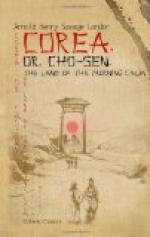One of the best features of Confucianism is the inculcation of respect towards parents and old people, in which respect both monks and nuns do a deal of good; though, otherwise, I think the country might advantageously be without these institutions.
Beliefs are comical when one does not believe in them.
On the mountain slopes, just outside the city wall, and at no great distance from the West Gate, is a peculiar rock, which the action of the weather has worn out into the shape of a gigantic tooth. Whence comes its name of Tooth-stone. There would be nothing wonderful about this, if it were not for the fact that a visit to this freak of nature, has, according to Corean accounts, the property of curing the worst of tooth-aches. Though I was not myself afflicted with the complaint in question, I went one afternoon to witness the pilgrimage that takes place every day to this miraculous spot. A little altar stands at the foot of the huge tooth, and numberless tablets, certifying to cures, erected by thankful noble visitors and others, are fixed against the rock, with the name, date and year when the cures were effected.
As I stood there, I could not help laughing at the sight of the crowds of men and women with swollen cheeks, bandaged up in cotton wool and kerchiefs, apparently undergoing excruciating agonies through coming out on so cold a day. One after the other they came up, first paying their chin-chins in front of the altar, and then depositing on it what cash they could afford; after which they proceeded to rub one cheek after the other on the Tooth-stone, just as “puss” rubs herself against your legs when you stroke her head. The bandages had, of course, to be removed before the balloon-like cheek could be rubbed on the frozen stone, and to watch the different expressions of relief or increased pain upon their ill-balanced, inflamed faces, gave me as much amusement as any show that I have ever witnessed. Should the pain have temporarily disappeared, the




